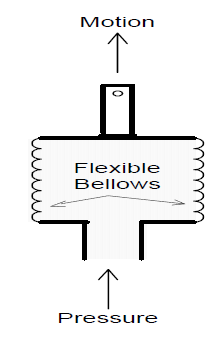In this post i'll try to cover the basics of pressure and the various principles associated with it. Pressure is probably most common measured variable in any industrial plant. it includes the measurement of steam pressure, feed water pressure, lubricating oil pressure, condenser pressure and many more.
Pressure: Pressure is actually the measurement of a force acting over a unit area. This can be denoted in equation form as shown below:

The units of measurements used are either in pounds per square inch(PSI) in British units or Pascals(Pa) in metric units. Since one PSI is approximately 7000 Pa, we often use kPa and MPa as units of pressure.
Before we start with the principles of measuring and sensing pressure, its best to setup some ground (basic) rules. Such as pressure varying depending on altitude above sea level, weather pressure fronts and other conditions. The measure of pressure, is, therefore relative and pressure measurements are stated as either gauge or absolute.
Gauge Pressure: Gauge pressure is the pressure which we encounter in out daily life. The best example would be tire ratings, which are in gauge pressure.
A gauge pressure device will indicate zero pressure when bled down to atmospheric pressure( i.e., atmospheric pressure is used as reference by the gauge pressure). Gauge pressure is denoted as (g) at the end of pressure unit. [e.g.: kPa (g)].
Absolute Pressure: Absolute pressure includes the effect of atmospheric pressure with the gauge pressure. It is denoted by (a) at the end of the pressure unit. [e.g. kPa (a)]. An absolute pressure indicator would indicate atmospheric pressure when completely vented down to atmosphere, it would not indicate zero scale.
Absolute Pressure = Gauge Pressure + Atmospheric Pressure
The understanding to this concept is illustrated in the below diagram:

In majority of pressure measurements in a plant are in gauge. Absolute measurements tend to be used where pressures are below atmosphere, mostly near the condenser and the vacuum units.
Pressure Measurement And Sensing Elements:
Principle of pressure measurement: Pressure works on Hook's law. (i.e., Measuring the stores in an elastic medium).
The objective of a pressure sensing element is to produce a dial indication, control operation or a standard (4 - 20 mA) electronic signal that represents the pressure in a process. To achieve this most pressure sensors translate pressure into physical motion that is in proportion to the applied pressure. The most common pressure sensors or primary pressure elements are described below:
1) Bourdon Tubes: Bourdon tubes are circular-shaped tubes with oval cross-sections. The pressure of the medium acts on the inside of the tube. The outward pressure on the oval cross section forces it to become rounded. Because of the curvature of the tube ring, the bourdon tube then bends as indicated in the direction of the arrow.

Due to their robust construction, bourdon tubes are mostly used in harsh conditions and high pressures, but can also be used for low pressures; the response time is however slower than the bellows or the diaphragms.
Some of the type of bourdon tubes are: 'C' type, spiral and helical.
2) Bellows: Bellows type elements are constructed of tubular membranes that are convoluted around the circumference. The membrane is attached at one end of the source and the other end is attached to the indicating device or instrument. The bellows element can provide a long range of motion (stroke) in the direction of the arrow when input pressure is applied.

3) Diaphragms: A diaphragm is a circular-shaped convolution membrane that is attached to the pressure fixture around the circumference. The pressure medium is on one side, and the indication medium is on the other. The deflection that is created by pressure in the vessel would be in the direction of the arrow indicated in the diagram show below.

Diaphragms provide fast acting and accurate pressure indication. However, the movement or stoke is not as large as the bellows.
4) Capsules Or Pressure Capsules:
There are 2 different types of capsules:
(a) In the first type, the pressure is applied to the inside of the capsule and if it is fixed only at the air inlet it can expand like a balloon. This arrangement is not much different from the diaphragm except that it expands in both ways, this can be seen in the diagram shown below.

The capsule consists of two circular-shaped, convoluted membranes (usually stainless steel) sealed tight around the circumference. The pressure acts on the inside of the capsule and the generated stroke movement is shown in the direction of the arrow.
(b) Differential Pressure Transmitter (D-P Transmitter):

In this type, the capsule in the bottom is constructed with two diaphragms forming an outer case and the inter-space with viscous oil. Pressure is applied to both side of the diaphragm and it will deflect towards the lower pressure.
To provide over-pressurized protection, a solid state with diaphragm-matching convolutions is usually mounted in the center of the capsule. Silicone oil is then used to fill the cavity between the diaphragms for even pressure transmission. Most DP capsules can withstand high static pressure of up to 14 MPa (2000 PSI) on both sides of the capsule without any damaging effect. However, the sensitivity range of DP capsules are quite low. Typically, they are sensitive up to only a few 100 kPa of differential pressure. Differential pressure that is significantly higher than the capsule range may damage the capsule permanently.

No comments:
Post a Comment